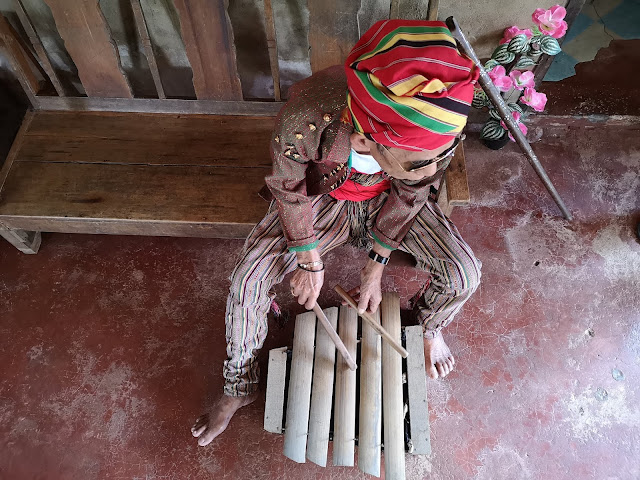I went to Basilan recently and on our last day, my traveling companion insisted we visit the two National Living Treasures, or the Gawad Manlilikha ng Bayan (GAMABA) awardees residing in Basilan.
It was a difficult itinerary to arrange and I was a bit wary because of Basilan’s reputation, but luckily, our hosts from the Department of Education, led by Schools Division Superintendent, Hilda Babon, helped arranged our visits.
Up to this day, I cannot believe how fortunate we were to be given the chance to meet, not just one, but two GAMABAs in one day! And how lucky of Basilan to have two GAMABA awardees.
GAMABA is an award that recognizes the finest traditional artists of the land. These awardees adopt a program that will ensure the transfer of their skills to others, and undertake measures to promote it. The award is administered and implemented by the National Commission for Culture and the Arts (NCCA).
I actually made it a travel goal to meet all of the Philippines’ living treasures. In 2014, I went to Lake Sebu to visit Lang Dulay, a T’boli traditional weaver credited for preserving the T’nalak, a dyed fabric made from abaca fiber. A year after, I met epic chanter Federico Caballero from the Panay-Bukidnon cultural group in Calinog, Iloilo when our group, TRails to Empower Kids or TREK, conducted an outreach there.
So, I was excited to get to meet my third and fourth GAMABAs.
We left Isabela City early in the morning, after having a quick breakfast at our hotel, the Basilan Business Hotel. It was more than an hour’s drive from there to Lamitan City, and we got to see the rest of the province, which is known for its rubber plantation. We also passed by the new Autonomous Region of Muslim Mindanao (ARMM) government center being built there.
Our first stop was the weaving center where Ambalang Ausalin, or Apuh Ambalang, was waiting for us. Apuh Ambalang is a Yakan tennun (tapestry) weaver.
My first encounter of Yakan weavers was in Zamboanga City in 2014, where I got my first Yakan weave, the 70 design, which they said is a rare piece. The Yakans are originally from Basilan Island, but conflicts led them to settling in Zamboanga City. That short visit got me really interested in their weaving tradition and I didn’t think I would be given the chance to visit their homeland.
We paid a courtesy call first to the barangay officials before proceeding to the weaving center, which is actually just about half a kilometer away from the barangay hall.
In the center, women and children, dressed in traditional attire were busy producing in their looms colorful textiles with intricate designs. I was not expecting such a busy and vibrant weaving center.
Apuh Ambalang was seated beside the entrance and we did not waste a single minute. We had our photos taken immediately, and after that, we went around and chatted with the ladies, who gave us a quick tour of the center, plus a brief introduction.
The process starts with the paghani, or the warping process, where threads are pulled and evenly placed through a bamboo comb. The closer its teeth, the tighter the designs will be. Next is the pagpeneh, or the making of the design. This is done by counting the threads of the loom for each row and bundling each vertical row with a separate piece of yarn. Last is the magtennun, or the actual weaving. Yakan weavers uses the back strap tension loom.
It is such a complex process so I was really amazed to see little girls practicing the art. I questioned myself and what I was doing when I was their age. These girls are very blessed.
After the weaving center, we headed back to Isabela City to see Uwang Ahadas, another GAMABA awardee.
Uwang Ahadas is also a Yakan who made it his life’s work to preserve and promote Yakan traditional music and instruments. He has mastered the gabbang, the agung, the kwintangan kayu, and others. Kwintanganis is typically played by a woman so he broke tradition by mastering this instrument.
Despite near-blindedness, he graciously welcomed us and even performed for us. How fortunate we are to experience a private concert by a master despite the challenges he faces! He went a step further, expressing regret that most of his instruments were in Cotabato City due to an ongoing event.
This encounter not only showcased his exceptional talent but also revealed his generosity and dedication to sharing his artistry, leaving a lasting impression on those fortunate enough to witness his performance.
The entire afternoon felt incredibly surreal, creating a truly unforgettable experience. It was a magical and mesmerizing journey through the realm of music, providing a unique glimpse into the depth of the Yakan culture.
We are extremely grateful to the people of Basilan. I swear, I did not expect Basilan to give me some of my most memorable travel experiences ever. I know that there is a lot more to discover here, but I'm reserving them for future visits.
















0 comments